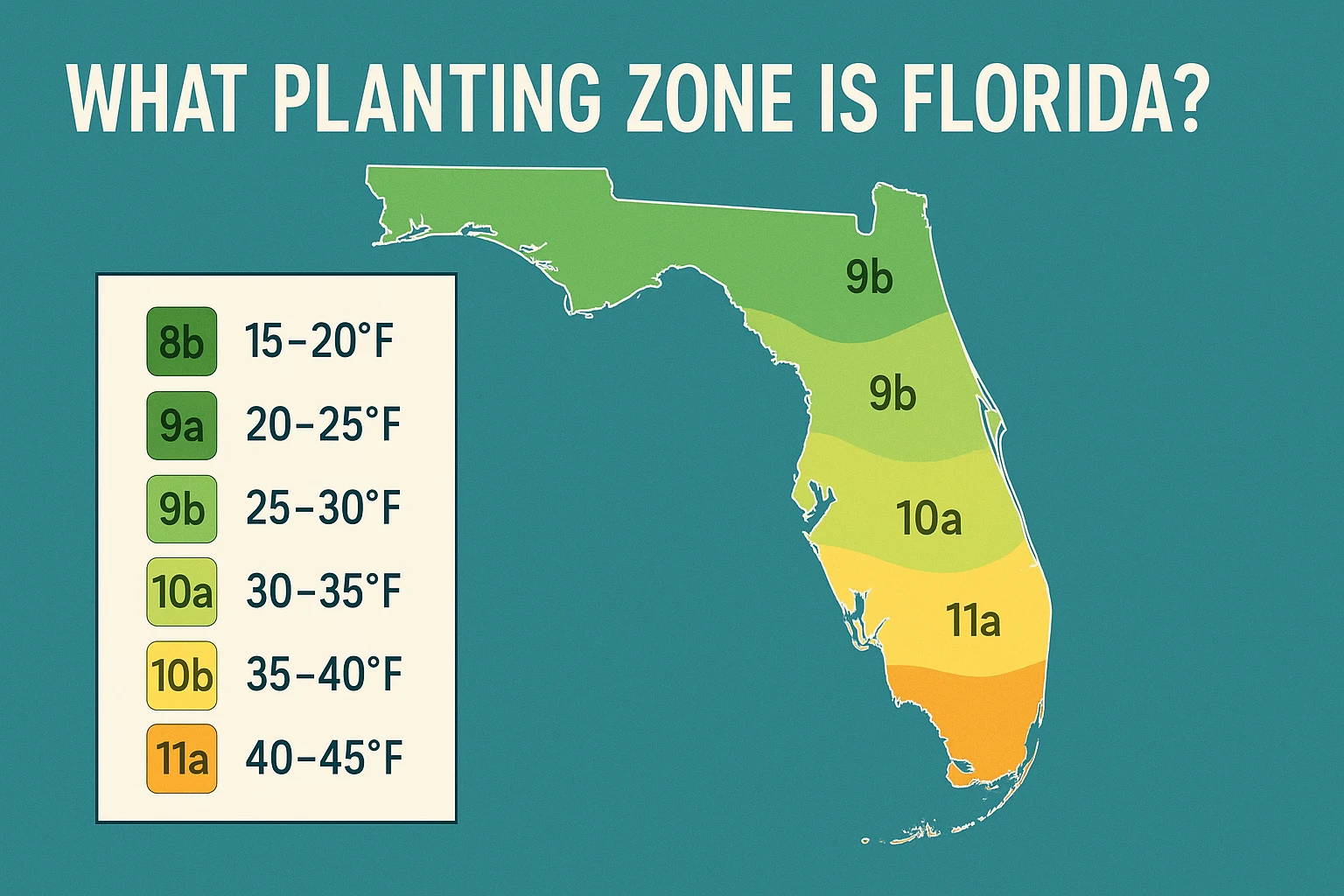What Planting Zone is Florida?[Map, Cities, and Growing Tips]

If you’re planning a garden in the Sunshine State, knowing what planting zone is Florida becomes essential. Florida’s tropical and subtropical climates allow for lush gardens, but the state spans several USDA zones, each with unique growing conditions.
In this guide, we’ll cover what planting zone is Florida, break it down by city, explain why it matters, and give practical tips to help your plants thrive.
🌴 What Planting Zone is Florida?
Florida spans across USDA Plant Hardiness Zones 8a through 11a. Here’s a breakdown:
| Region | USDA Zone |
|---|---|
| Northern Florida | Zone 8a–9a |
| Central Florida | Zone 9b–10a |
| Southern Florida & Keys | Zone 10b–11a |
When you search for what planting zone is Florida, remember that zones are defined by the average minimum winter temperatures. For example, Zone 8a experiences occasional lows of 10–15°F, while Zone 11a rarely sees temperatures below 40°F.
📍 Florida Planting Zones by Major Cities
To simplify what planting zone is Florida for gardeners, here’s a city-specific chart:
| City | Planting Zone |
|---|---|
| Tallahassee | Zone 8b |
| Gainesville | Zone 9a |
| Orlando | Zone 9b |
| Tampa | Zone 10a |
| Fort Myers | Zone 10a |
| Miami | Zone 10b |
| Key West | Zone 11a |
| Jacksonville | Zone 9a |
| Ocala | Zone 9a |
| Pensacola | Zone 9a |
This helps answer what planting zone is Florida for your specific location. Coastal areas stay warmer, while northern inland regions can dip into colder temperatures.
🌡️ Why Knowing What Planting Zone is Florida Matters?
Understanding what planting zone is Florida isn’t just trivia — it directly affects your gardening success. Zones determine:
- Which perennials survive winter
- When to plant vegetables
- What tropical plants thrive year-round
- Frost dates and growing season length
For example, bananas and mangoes do great in Zone 10b but would struggle in Zone 8b without protection.
🍅 Example: Tomato Growing in Florida’s Zones?
In Zone 8b (Tallahassee), tomato planting starts around mid-March. In Zone 10a (Tampa), gardeners can plant tomatoes as early as January. Zone 11a (Key West) allows nearly year-round warm-weather planting.
The higher the zone, the longer your growing season. That’s why understanding what planting zone is Florida is crucial for maximizing yields.
📅 Florida Gardening Calendar by Zone
| Crop Type | Zone 8b Start | Zone 9b Start | Zone 10b+ Start |
|---|---|---|---|
| Cool-season crops | Feb–Mar | Jan–Feb | Dec–Jan |
| Warm-season crops | Mar–Apr | Jan–Feb | Year-round |
| Citrus & Tropicals | May | Feb–Mar | Year-round |
When you’re figuring out what planting zone is Florida, timing is everything.
🌱 Growing Tips for Florida’s Diverse Zones
Whether you’re in North Florida or the Keys, these tips apply:
✅ Do:
- Use mulch to retain soil moisture and control weeds
- Select plants rated for your zone (8a–11a)
- Watch for fungal diseases in humid regions
- Amend sandy soils with organic matter
❌ Avoid:
- Overwatering during the rainy season
- Planting tender crops before the last frost in Zone 8b–9a
- Ignoring salt tolerance in coastal areas
🗺️ How to Check Your Exact Zone in Florida
For a precise answer to what planting zone is Florida for your zip code, use the USDA Plant Hardiness Zone Map. Enter your zip code to confirm your specific microclimate.
🧮 Recommended Calculators for Florida Gardeners
Take the guesswork out of gardening:
- Soil Volume Calculator – Know exactly how much soil you need for raised beds.
- Plant Spacing Calculator – Prevent overcrowding and maximize yield.
- Indoor Plant Watering Calculator – Perfect for your houseplants or container garden.
❓ Frequently Asked Questions
What planting zone is Florida in general?
Florida ranges from Zone 8a in the north to Zone 11a in the Keys. Coastal and southern regions are generally warmer.
Can I grow citrus anywhere in Florida?
Citrus grows well in Zones 9b and warmer. In Zone 8b, it requires frost protection during winter.
When is the last frost in Florida?
- Zone 8b: Late March
- Zone 9a: Early March
- Zones 10–11: Frost is rare to nonexistent
✅ Conclusion: Why Knowing What Planting Zone is Florida Matters
Whether you’re a backyard gardener or starting a tropical oasis, knowing what planting zone is Florida helps you select the right plants and plan accordingly. From the frosty edges of North Florida to the tropical warmth of the Keys, each zone shapes what you can grow and when.
Before you plant, double-check your zone — your plants will thank you.
